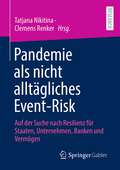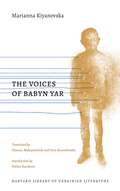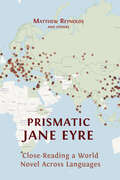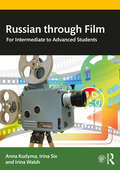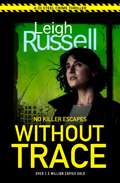- Table View
- List View
An Outline of Romanticism in the West
by John Claiborne IsbellNavigating the landscape of Romantic literature and art across Europe and the Americas, An Outline of Romanticism in the West invites readers to embark upon a literary journey.
Pandemie als nicht alltägliches Event-Risk: Auf der Suche nach Resilienz für Staaten, Unternehmen, Banken und Vermögen
by Tatiana Nikitina Clemens RenkerSchnell und agil lieferten erstmals via Zoom-Seminare renommierte Wissenschaftler aus Deutschland, Russland und Polen während der Pandemie 2020/2021 Antworten für mehr Widerstandsfähigkeit in Wirtschaft und Gesellschaft. Die zusammengefassten Beiträge bieten Lösungsanstöße für wirtschaftliche, soziale, rechtliche und gesellschaftliche Fragen aufgrund der Auswirkungen von COVID-19. Insbesondere werden die internationale Unternehmensbesteuerung, die Zukunft des Bankensektors, die Stabilität des Arbeitsmarktes, Entwicklungen auf den Immobilienmärkten, Optimierungen der städtischen Logistik, Herausforderungen für das Gesundheitssystems, die Sicherung der Beschäftigung, Probleme des Rentensystems und innovative Geschäftsmodelle thematisiert. Das International Centre for Financial Markets Research ICFMR der Staatlichen Universität für Wirtschaft Sankt Petersburg und der „Petersburger Dialog“ unterstützten die laufende Partnerschaft zwischen Deutschland und Russland in den schwierigen Zeiten: Für Frieden und Wohlstand.
THE VOICES. OF BABYN YAR
by Marianna KiyanovskaWith The Voices of Babyn Yar—a collection of stirring poems by Marianna Kiyanovska— the award-winning Ukrainian poet honors the victims of the Holocaust as she writes their stories of horror, death, and survival by projecting their own imagined voices. Artful and carefully intoned, the poems convey the experiences of ordinary civilians going through unbearable events leading to the massacre at Kyiv’s Babyn Yar from a first-person perspective to an effect that is simultaneously immersive and estranging. While conceived as a tribute to the fallen, the book raises difficult questions about memory, responsibility, and commemoration of those who had witnessed an evil that verges on the unspeakable.
Prismatic Jane Eyre: Close-Reading a World Novel Across Languages
by Matthew Reynolds OthersJane Eyre, written by Charlotte Brontë and first published in 1847, has been translated more than five hundred times into over sixty languages. Prismatic Jane Eyre argues that we should see these many re-writings, not as simple replications of the novel, but as a release of its multiple interpretative possibilities: in other words, as a prism. Prismatic Jane Eyre develops the theoretical ramifications of this idea, and reads Brontë’s novel in the light of them: together, the English text and the many translations form one vast entity, a multilingual world-work, spanning many times and places, from Cuba in 1850 to 21st-century China; from Calcutta to Bologna, Argentina to Iran. Co-written by many scholars, Prismatic Jane Eyre traces the receptions of the novel across cultures, showing why, when and where it has been translated (and no less significantly, not translated – as in Swahili), and exploring its global publishing history with digital maps and carousels of cover images. Above all, the co-authors read the translations and the English text closely, and together, showing in detail how the novel’s feminist power, its political complexities and its romantic appeal play out differently in different contexts and in the varied styles and idioms of individual translators. Tracking key words such as ‘passion’ and ‘plain’ across many languages via interactive visualisations and comparative analysis, Prismatic Jane Eyre opens a wholly new perspective on Brontë’s novel, and provides a model for the collaborative close-reading of world literature. Prismatic Jane Eyre is a major intervention in translation and reception studies and world and comparative literature. It will also interest scholars of English literature, and readers of the Brontës.
Prismatic Jane Eyre: Close-Reading a World Novel Across Languages
by Matthew Reynolds OthersJane Eyre, written by Charlotte Brontë and first published in 1847, has been translated more than five hundred times into over sixty languages. Prismatic Jane Eyre argues that we should see these many re-writings, not as simple replications of the novel, but as a release of its multiple interpretative possibilities: in other words, as a prism. Prismatic Jane Eyre develops the theoretical ramifications of this idea, and reads Brontë’s novel in the light of them: together, the English text and the many translations form one vast entity, a multilingual world-work, spanning many times and places, from Cuba in 1850 to 21st-century China; from Calcutta to Bologna, Argentina to Iran. Co-written by many scholars, Prismatic Jane Eyre traces the receptions of the novel across cultures, showing why, when and where it has been translated (and no less significantly, not translated – as in Swahili), and exploring its global publishing history with digital maps and carousels of cover images. Above all, the co-authors read the translations and the English text closely, and together, showing in detail how the novel’s feminist power, its political complexities and its romantic appeal play out differently in different contexts and in the varied styles and idioms of individual translators. Tracking key words such as ‘passion’ and ‘plain’ across many languages via interactive visualisations and comparative analysis, Prismatic Jane Eyre opens a wholly new perspective on Brontë’s novel, and provides a model for the collaborative close-reading of world literature. Prismatic Jane Eyre is a major intervention in translation and reception studies and world and comparative literature. It will also interest scholars of English literature, and readers of the Brontës.
Russian through Film: For Intermediate to Advanced Students
by Anna Kudyma Irina Six Irina WalshRussian through Film: For Intermediate to Advanced Students is a multi-level textbook for learners of Russian that targets contemporary films in Russian. These films will deepen learners’ understanding of today’s lifestyles in the post-Soviet space as well as add to their understanding of Soviet and Russian history and culture. They represent a variety of genres ranging from romantic comedy to art-house cinema. These films present standard Russian and are appropriate for various audiences. Russian through Film builds on students’ listening, reading, speaking, and writing skills while also expanding their cultural literacy. The textbook aims at improving learners’ ability to analyze films by carefully investigating the films’ plot, structure, conflicts, and main characters. Through task-based, inquiry-based, and project-based activities, the textbook focuses on developing learners’ skills in various modes of discourse (narration, description, comparison, explanation, and summary). The textbook can serve as a primary text for a course on contemporary Russian films or a supplementary textbook in intermediate and advanced level classes. Separate chapters may be included in thematic classes on youth culture, Soviet history, sports, geography, folklore, contemporary social issues, and the arts.
Russian through Film: For Intermediate to Advanced Students
by Anna Kudyma Irina Six Irina WalshRussian through Film: For Intermediate to Advanced Students is a multi-level textbook for learners of Russian that targets contemporary films in Russian. These films will deepen learners’ understanding of today’s lifestyles in the post-Soviet space as well as add to their understanding of Soviet and Russian history and culture. They represent a variety of genres ranging from romantic comedy to art-house cinema. These films present standard Russian and are appropriate for various audiences. Russian through Film builds on students’ listening, reading, speaking, and writing skills while also expanding their cultural literacy. The textbook aims at improving learners’ ability to analyze films by carefully investigating the films’ plot, structure, conflicts, and main characters. Through task-based, inquiry-based, and project-based activities, the textbook focuses on developing learners’ skills in various modes of discourse (narration, description, comparison, explanation, and summary). The textbook can serve as a primary text for a course on contemporary Russian films or a supplementary textbook in intermediate and advanced level classes. Separate chapters may be included in thematic classes on youth culture, Soviet history, sports, geography, folklore, contemporary social issues, and the arts.
Without Trace: An Utterly Gripping Detective Crime Thriller With An Unexpected Twist (Di Geraldine Steel Ser. #20)
by Leigh RussellHow Divine Images Became Art
by Oleg TarasovHow Divine Images Became Art tells the story of the parallel ‘discovery’ of Russian medieval art and of the Italian ‘primitives’ at the beginning of the twentieth century. While these two developments are well-known, they are usually studied in isolation. Tarasov’s study has the great merit of showing the connection between the art world in Russia and the West, and its impact in the cultural history of the continent in the pre-war period.
Translating Russian Literature in the Global Context
by Muireann Maguire Cathy McAteerTranslating Russian Literature in the Global Context examines the translation and reception of Russian literature as a world-wide process. This volume aims to provoke new debate about the continued currency of Russian literature as symbolic capital for international readers, in particular for nations seeking to create or consolidate cultural and political leverage in the so-called ‘World Republic of Letters’. It also seeks to examine and contrast the mechanisms of the translation and uses of Russian literature across the globe. This collection presents academic essays, grouped according to geographical location, by thirty-seven international scholars. Collectively, their expertise encompasses the global reception of Russian literature in Europe, the Former Soviet Republics, Africa, the Americas, and Asia. Their scholarship concentrates on two fundamental research areas: firstly, constructing a historical survey of the translation, publication, distribution and reception of Russian literature, or of one or more specific Russophone authors, in a given nation, language, or region; and secondly, outlining a socio-cultural microhistory of how a specific, highly influential local writer, genre, or literary group within the target culture has translated, transmitted, or adapted aspects of Russian literature in their own literary production. Each section is prefaced with a short essay by the co-editors, surveying the history of the reception of Russian literature in the given region. Considered as a whole, these chapters offer a wholly new overview of the extent and intercultural penetration of Russian and Soviet literary soft power during the twentieth and twenty-first centuries. This volume will open up Slavonic Translation Studies for the general reader, the student of Comparative Literature, and the academic scholar alike.

